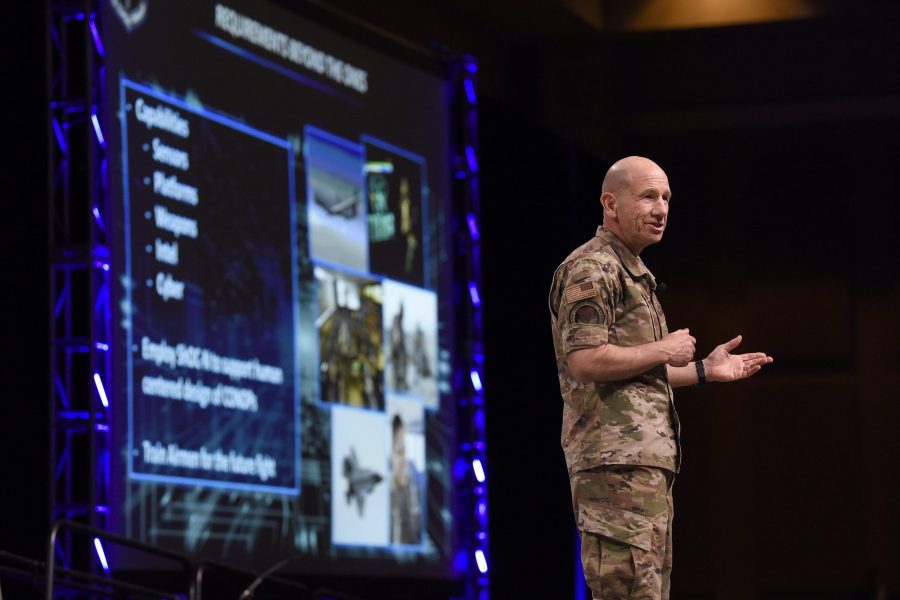ORLANDO, Fla.—Air Combat Command is shifting from a “fighter roadmap” to a “capabilities” roadmap that will capture many of the things fighters do today, but likely with new types of unmanned systems and “attritable” aircraft, Air Combat Command boss Gen. Mike Holmes said Feb. 27.
Speaking with reporters at an AFA Air Warfare Symposium press conference, Holmes said ACC is grappling with “what is a fighter?” in the future. The fighter mission will give way to “attritable” aircraft and “loyal wingmen” unmanned aircraft, in addition to fighters, and possibly different kinds of manned aircraft. The roadmap will be very much dependent on the theaters in which the assets will be used.
“What I would rather build is a capabilities roadmap that shows how we’re going to accomplish the missions for the Air Force that we traditionally have done with fighters,” Holmes said. “And the subtlety there is, I would hope, 30 years from now, I’m not still trying to maintain 55 fighter squadrons. I think we will have advanced and there will be some other things that we’ll be cutting-in.”
The roadmap is in roughly five-year stages, which parallel “natural decision points” affecting chunks of the fleet, Holmes explained.
The first stage seeks a replacement for the F-15C fleet, which is now aging out of the inventory. Those aircraft will be replaced by F-35s and the new F-15EXs, Holmes reported. The EXs are needed to reduce the overall age of the fighter fleet “so we can afford to sustain it,” he said, noting the EX is “what’s available to us now.”
The next stage “will be what we call the pre-block F-16s—the Block 25 and 30 Fighting Falcons—that we’re still flying.” Within the next eight years, “depending on budgets and capabilities, we’ll have to decide what we’ll do about those airplanes,” Holmes said. There is an “opportunity” to cut-in “something new: low cost, attritable [aircraft], loyal wingmen, various things we’re … experimenting with.”
After that, ACC will confront “the post-Block F-16s—the Block 40s and 50s—that can fly for quite a bit longer, but there is a modernization bill that would have to be spent to keep them useful,” Holmes said, suggesting further service life extension for the F-16 may be coming.
Gen. Arnold Bunch, commander of Air Force Materiel Command, said the F-16 post-block fleet could be extended for as much as another 10 years of service life, starting in the mid-20s. A SLEP would have to focus first on making them safe to fly, he said, and they would need technology insertions to make them relevant, “depending on what you use them for.” The aircraft will already have Active Electronically Scanned Array radars and digital backbones, he noted.
Finally, ACC is trying to decide what the Next-Generation Air Dominance system should be.
“The equation and the math we use for ‘what is a fighter’ still works pretty well for the European environment—the range, payload, and distance problem,” Holmes noted. But “it’s not as effective a solution in the Pacific because of the distances,” and for that theater, he said, “I wouldn’t expect [NGAD] to produce things that necessarily look like a traditional fighter, or in that traditional swap between range and payload that we’ve done.”
Pacific Air Forces boss Gen. Charles Q. Brown, Jr. said in the future a family of systems approach will be more useful given the size of the area of operations and the differences in the adversary.
“The family of systems provides us some level of advantage. If you’re looking for a single point solution that has to be a fighter. It’s the fighter, but not the information that comes off the fighter, the information the fighter gets from other platforms … ,” Brown said. “How all that comes together will be important to support the fighter of the future, or whatever capability we have.”
Holmes said Will Roper, the Air Force acquisition chief, is thinking about more low-cost “attritable” options for the Pacific, “thinking about that long-range problem, what might we come up with.” He has previously allowed that something akin to a large missileer, potentially a variant on the B-21, could be part of the mix, and ACC is also thinking about an “arsenal plane” concept.
“Those discussions are going on, and they should be,” Holmes added. But “it is still … our responsibility to the rest of the force to control the air and space on their behalf.”
Roper’s team is working with industry to pursue a new “digital” prototyping approach that Holmes said he’s pleased with. He noted that Boeing was able to win the T-7 competition by showing it can “design and build airplanes in a different way and at a cost point nobody expected,” and “we think we have the opportunity to spread that across the other things we’re doing.” He also says there is support from Capitol Hill with the approach at this stage, and ACC is working hard to share information on the future of ACC combat capabilities at “the right level” of classification.
